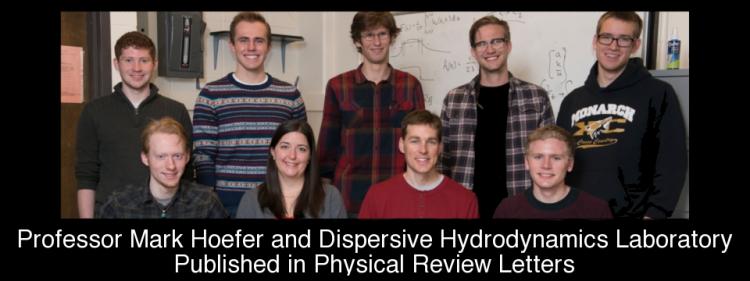
Professor Mark Hoefer has been published in the esteemed physics journal Physical Review Letters. The journal publishes “short, high quality reports of significant and notable results in the full arc of fundamental and interdisciplinary physics research”. The publication, Observation of Dispersive Shock Waves, Solitons, and Their Interactions in Viscous Fluid Conduits, is co-authored by two CU Boulder undergraduate students, Dalton Anderson and Marika Schubert, and a CU Boulder graduate student, Michelle Maiden. Anderson, Schubert, and Maiden all are or were members of Professor Hoefer’s Dispersive Hydrodynamics Laboratory. The project began when Professor Hoefer received a National Science Foundation Career Award in 2013. The grant led to the formation of the Dispersive Hydrodynamics Laboratory and numerous publications.
This publication reports experiments on dispersive shock waves and solitons propagating along the interface between two viscous fluids. Mathematically, solitons are localized wave solutions of partial differential equations that maintain their shape and speed during propagation due to a balance between dispersion and nonlinearity. Solitons exhibit the remarkable property that they interact elastically, i.e., each soliton maintains the same shape and speed even after interacting with another soliton. Dispersive shock waves (DSWs), on the other hand, are spatially extended, dynamically expanding oscillatory trains of amplitude-ordered nonlinear wave solutions of hyperbolic equations regularized by dispersion. They are the dispersive analogue of classical, viscous shock waves. Their mathematical study is relatively mature (see the review co-authored by Professor Hoefer) and DSWs arise in many different circumstances (tsunami, Bose-Einstein condensates, superfluids, and others) but they have been difficult to study experimentally. A buoyantly rising conduit of viscous fluid inside of a heavier, much more viscous fluid can behave like a deformable pipe and was predicted by Professor Hoefer to exhibit DSWs. In this paper, DSWs were created, their speeds and amplitudes measured and compared with a nonlinear wave averaging theory called Whitham theory. Additionally, the interaction of a soliton with a DSW were shown to exhibit an elastic interaction whereby the soliton either passes through the DSW or is absorbed by the DSW, leaving the DSW unchanged except for a small phase shift. Two interacting DSWs were also shown to merge together into a single one. These results are the first high-fidelity experiments of DSWs, solitons, and their interactions. The viscous fluid conduit system holds great promise as a model "superfluid-like" dispersive hydrodynamic system.

